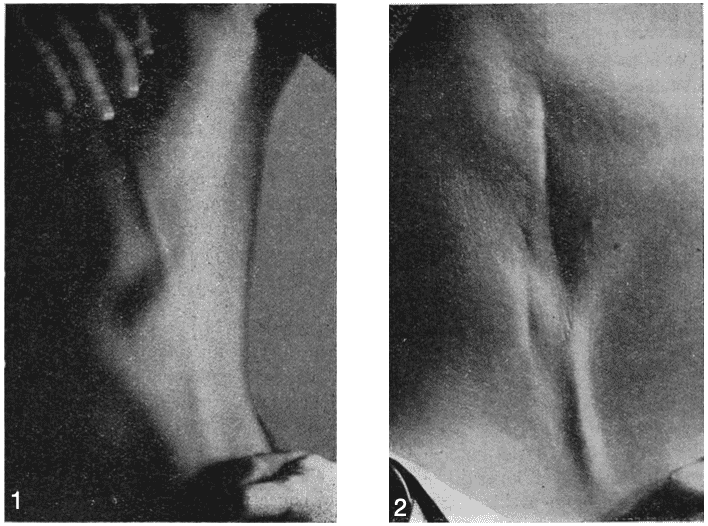Mondor disease
Description
Mondor disease is a rare, benign condition characterized by thrombophlebitis of the subcutaneous veins of the breast and anterolateral chest wall. Patients usually present with a painful breast (cord-like) mass. There may be overlying skin erythema. It may be accentuated when the ipsilateral arm is raised.
Mondor disease can also occur in the dorsal veins of the penis (Penile Mondor disease, PMD).
History of Mondor disease
1869 – Charles Hilton Fagge (1838-1883) reported the occurrence of superficial thrombophlebitis of the breast which he thought to be related to scleroderma
1939 – During the session of the Academy of Surgery on December 6, Henri Mondor described a clinical entity of which it was impossible “to give a precise name”. He provided the title of “Subacute subcutaneous tronculitis of the anterolateral chest wall“
His work was based on four observations, but he described more precisely the case of a 30-year-old woman referred by her attending physician for a “small hard cord under the left breast” which occurred “following a fall on the edge of a crate“.
En relevant un gros sein tombant de femme grasse et en tendant ainsi de bas en haut les
téguments de la région sous-mammaire, on voit se dessiner, nettement, sur la paroi thoracique une sorte de relief linéaire qui descend à peu près verticalement, sur 20 à 25 centimètres environ de longueur, allant du sein au rebord costal inférieur. À la palpation, on sent un cordon induré de 2 à 3 millimètres de diamètre qui fait sous le doigt la saillie d’un petit crayon; ce cordon est à peine douloureux, il donne la sensation que donnerait, avec son diamètre approximatif et à peu près sa consistance, une sonde urétérale, ou mieux une plume d’oie fixée, faufilée sous la peau et au plus près de celle-ci.
By raising a large drooping breast of a fat woman and thus stretching from bottom to top the integuments of the sub-mammary region, one sees clearly emerging on the chest wall a kind of linear relief which descends almost vertically, about 20 to 25 centimeters in length, going from the breast to the lower costal edge. On palpation, one feels a hard cord 2 to 3 millimeters in diameter which protrudes under the finger like a small pencil; this cord is barely painful, it gives the sensation that, with its approximate diameter and roughly its consistency, a ureteral catheter would give, or better a fixed goose feather, threaded under the skin and as close as possible to it .

(1) Tronculite de la paroi thoracique antéro-latérale gauche. (2) Tronculite subaiguë de la paroi thoracique. Mondor 1939
1951 – In his publication Thrombophlebites and periphlebites of the anterior chest wall, Mondor, gave a more detailed study of this disease which he called his “little disease”. A condition usually affecting adult women between the ages of 30 and 60 years with extremes ranging from 19 to 70 years. A few rare cases have been reported in adolescents.
This disease remains rare since 313 cases were reported between 1939 and 1992
Associated Persons
- Charles Hilton Fagge (1838-1883)
- Henri Mondor (1885-1962)
Alternative names
- Mondor’s disease
References
Historical references
- Fagge CH. Remarks on certain cutaneous affections. Guys Hosp Rep 1870; 15 : 295-364
- Mondor H. Tronculite sous-cutanée subaiguë de la paroi thoracique antéro-latérale. Mémoires de l’académie de chirurgie 1939; 65: 1271-1278.
- Mondor H. Phlebite en cordon de la paroi thoracique. Mémoires de l’académie de chirurgie 1944; 70: 96-98
- Mondor H, Bertrand L. Thrombophlébites et périphlébites de la paroi thoracique antérieure. La Presse Médicale, 1951; 59: 1533-1535.
Eponymous term review
- Conant EF, Wilkes AN, Mendelson EB, Feig SA. Superficial thrombophlebitis of the breast (Mondor’s disease): mammographic findings. AJR Am J Roentgenol. 1993; 160(6): 1201-3.
- Hermann JB. Thrombophlebitis of breast and contiguous thoracoabdominal wall (Mondor’s disease). NY State J Med 1966; 15 : 3 146-52.
- Sabaté JM, Clotet M, Gómez A, De Las Heras P, Torrubia S, Salinas T. Radiologic evaluation of uncommon inflammatory and reactive breast disorders. Radiographics. 2005; 25(2): 411-424
- Niechajev I. Mondor’s subcutaneous banding after transaxillary breast augmentation: case report and the review of literature. Aesthetic Plast Surg. 2013 Aug;37(4):767-9.
[cite]
eponymictionary
the names behind the name
